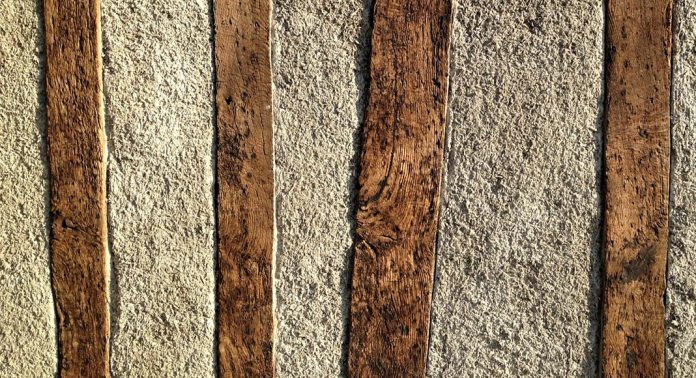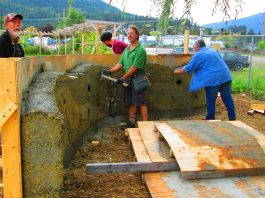Graham Durrant provides an overview of the burgeoning hempcrete industry, explaining why hemp should be viewed as a sustainable building material as well as some of the reasons why it is not as widely used as it could be.
Hemp can grow up to four metres high in three months without the use of pesticides and herbicides, and hemp production is expanding rapidly throughout the world. The recent expansion in this sector is down to several factors, not least the general feeling we all have that what we are doing with our planet is not quite working out. This feeling is gaining momentum, but it is at odds with our ‘business as usual’ approach to life. Hemp is a sustainable building material, and with its green credentials and multiple uses it is set to become a valuable crop for the future.
One of the most exciting, and arguably important, parts of this hemp renaissance is the gradual growth in the use of hemp as a building material. Hempcrete consists of hemp ‘shiv’, the woody core of the hemp plant broken up into something resembling fine wood chips, which is then mixed with a lime-based binder and water. This combination sets hard to become an excellent insulator for walls, floors, or roofs. Hempcrete has numerous advantages over other building materials, including being fireproof, non-toxic, sustainable, breathable, and highly insulative.
A truly sustainable building material
It is perhaps fair to say that climate change is the greatest threat to our future security, and our buildings are responsible for around half of greenhouse gas emissions, both during the construction process and in heating, cooling, and maintenance demands once inhabited. Hempcrete has the potential to reduce greenhouse gas emissions at each of these stages, making it a truly sustainable building material.
Plants absorb carbon from the atmosphere as they grow, and due to its rapid growth rate hemp is able to lock up more carbon per hectare than just about any other plant, including trees. When this biomass is harvested, mixed with lime, and put into a building, it locks up that carbon for the lifetime of the building. The lime also offsets the energy used to manufacture it by reabsorbing carbon dioxide from the atmosphere as it sets over time. Most conventional building materials have high embodied carbon, meaning that they emit significant levels of carbon dioxide into the atmosphere during their production. Hempcrete actually absorbs more carbon than it emits during its manufacture, making it carbon negative.
To put that into perspective: one cubic metre of hempcrete will sequester approximately 110kg of carbon from the atmosphere. An average sized house would be built using around 50 cubic metres of hempcrete for the walls, meaning that an average hempcrete house would lock up 5.5 tonnes of carbon for the lifetime of the building. This compares to a more standard new house of a similar size, in which the walls would be likely to emit 48 tonnes of carbon into the atmosphere.1 This is a saving of 53.5 tonnes of carbon for every house built. It is clear to see that the carbon balance is not even close and that, notwithstanding slight variations in calculation methodology, building with hempcrete can significantly reduce carbon emissions, making it a more sustainable building material.
Insulation
Hempcrete’s ability to save carbon does not stop there. Hempcrete is an insulative walling material and it has two crucial attributes in its favour to reduce carbon emissions and save on energy bills – the qualities of moisture management and thermal mass. Largely overlooked by building regulations, these attributes mean that hempcrete buildings require less energy to keep occupants warm and comfortable.
Anyone who has ever spent time in a damp room will know that relative humidity is crucial to maintaining comfort. Hempcrete’s ability to absorb and desorb moisture means that it will regulate humidity in the building and so comfort can be achieved at lower temperatures, with obvious savings on energy bills.
The thermally massive qualities of hempcrete allow the fabric of the building to warm up and stay warm, even when the air is changed. This contrasts with most modern buildings, where the positioning of the insulation layer in the wall near the interior surface means that the only thing in the room that is warm is the air. The major drawback here is that when any kind of ventilation or draught occurs the room temperature drops quickly, requiring the thermostat to cut in regularly and reheat the room. This too has obvious negative consequences for energy bills. Anybody who lives in a modern house and has noticed that as soon as the heating goes off the room temperature drops off quickly is experiencing this design error.
The post-occupancy survey of the Cheshire Oaks Marks and Spencer store built with hempcrete in 2012 in the UK found that the building used 60% less heating fuel than design energy evaluation calculations based on the predicted U values.2 This is not magic, and it is not even that surprising if we understand the limited contribution to energy performance that a simple U value calculation is capable of producing. It is a blunt tool to measure a complicated dynamic process that has moisture regulation and thermal mass at its heart, neither of which are considered in the steady state U value calculation. This limited way of looking at buildings and limited metric for anticipating building performance is standing steadfastly in the way of more natural and sustainable ways to build.
Slow progress
Hempcrete has been around now for almost forty years and its progress has been slow despite its numerous attributes. There are many reasons why progress has been slow, but none of them are really to do with shortcomings of the material. The hempcrete industry is in direct competition with other insulation material manufacturers who have a vested interest in maintaining the status quo. Their ability to invest in lobbying and to promote their version of building physics makes it difficult for new developments outside of their conservative industry to make headway.
A visit to almost any large housing development would allow an opportunity to see that the industry is still using the same high carbon building techniques it has been using for years. Packing in a little more ‘highly polluting’ insulation and a bicycle shelter to meet current environmental targets is not a solution to climate change. The high-energy and petrochemical-based materials designed to minimise labour needs, and get workers off site quickly, are leading to houses being built that are riddled with toxic materials, with inherent impacts on our health, particularly as our buildings are increasingly sealed for energy efficiency. One could easily be forgiven for thinking that the governments that rely on the construction industry to keep the economy buoyant are simply turning a blind eye to the industry’s appalling record regarding climate-changing emissions and pollution.
Experience and expertise
Within the hempcrete industry, if indeed it is an industry yet, there is a lack of expertise and experience as with any new industry. There are a few companies that are building and renovating with great success, but most of the buildings are one-off projects. The knowledge and skills required for these on-off projects are similar to, but not exactly the same as, building at larger volumes. There could be economies of scale applied to hempcrete buildings just the same as any other buildings, but scale requires investment and investment requires confidence. At present, the disparate, but successful, hempcrete builders are not uniting to provide this evidence in a robust and coherent form loud enough for government and investors to hear.
A possible future
As hemp growing expands across the world, and processing plants are established to separate fibre from shiv, the raw material for hempcrete will become increasingly available. If textile manufacturers can move away from cotton towards hemp then the hemp market will expand rapidly, and this should enable the price of hemp shiv to remain stable.
The growing CBD industry has attracted significant investment and this is also eroding the outdated laws that make hemp growing difficult to access. CBD stems can be used for hempcrete if taller varieties are cultivated, but some progress needs to be made in harvesting and clearing and cleaning technology.
Evidence for how we need to build is apparent in any hempcrete building, and we do not lack proof that current mainstream building practice is failing us if we bother to look. The Grenfell Tower fire has been a tragic wake-up call, and there are many other buildings out there silently underperforming, forcing yet more carbon into the atmosphere. Hempcrete is not a material with lots of unresolved issues. It is a material that is coming of age and which could enable us to build in a much more sustainable manner, resulting in better building performance. It just requires the political will and investment to move away from our self-destructive ‘business as usual’ approach.
References
- Berners-Lee, Mike. How Bad Are Bananas?: The Carbon Footprint of Everything. London: Profile Books, 2010
- Jugdoyal, Keeran & Croxford, Ben. Marks and Spencer Cheshire Oaks – Building Performance Evaluation First Year Performance Summary 25 September 2013. London: UCL, 2013
Graham Durrant
Hemp Lime Spray Ltd
+44 (0) 7552711004
hemplimespray@yahoo.com
http://hemplimespray.co.uk/
Please note, this article will also appear in the second edition of our new quarterly publication.









